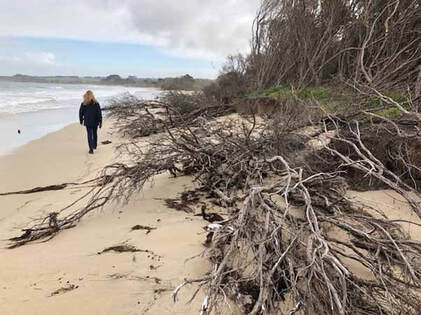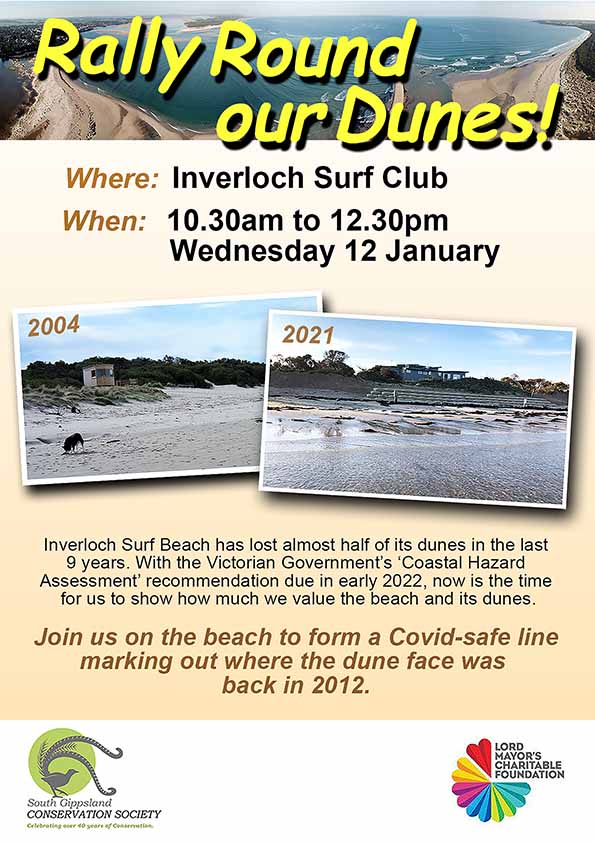 The next few months are critical in the fight to save the Inverloch surf beach.
The next few months are critical in the fight to save the Inverloch surf beach. THE Inverloch community is being tested by the rapid, on-going erosion of their much loved surf beach and its dunes. While the Victorian Government’s Cape to Cape Resilience Project is developing a long-term adaptation plan for the Inverloch coastline, there won’t be a beach to save unless action is taken soon.
After years of beach monitoring, reports, a documentary, interviews and discussions with authorities, South Gippsland Conservation Society’s Inverloch Coastal Resilience Project team is calling for urgent short-term action to save this beach.
We are proposing dune renourishment over the Wreck Creek and Flat Rocks sections of coastline, importing a total of around 17,500 tonnes of sand to restore the dune profile to what existed in 2018. The renourishment needs to be completed in early 2022, before the onset of the autumn and winter storm swells.
Our research indicates that wet sand fencing would assist in protecting and further building the renourished dunes over the Wreck Creek section of coastline, from the Cape Paterson Road rock wall to the former Wreck Creek entrance, a distance of 325 metres.
The approach of providing short-term protection while longer-term planning is underway has been followed at other at-risk Victorian beaches, such as Apollo Bay, so we can’t understand why there seems to be so much reluctance to do the same at Inverloch.
| What’s changed? Over the past decade, up to 70 metres of the vegetated dunes that existed behind the 2-kilometre-long Inverloch Surf Beach in 2012 have been swept away. This is the most rapid change recorded along the Victorian coastline in European historical times. At Wreck Creek, west of the Surf Lifesaving Club, there is only one metre of dune left between the ocean and the creek, with the estuarine lagoon system behind the dune under imminent threat. At Flat Rocks, at the western end of the beach, 80-year-old coast banksias are being undermined and falling into the sea. In the past ten years, over 8 hectares of dune vegetation have been lost, almost half of the total area of vegetated dunes that existed in 2012. From being a wide, gently sloping beach backed by more than 100 metres of vegetated dune, the surf beach is now much narrower, with little or no dry sand at high tide. It is strewn with fallen and dying vegetation, backed by a thin strip of steeply eroded dunes. Access tracks through the dunes have had to be closed and the surf lifesaving club lookout tower relocated three times. Our research indicates the main contributing factors for the rapid changes are increases in the frequency and intensity of erosion-inducing storms and bigger ocean swells, combined with rising sea levels. Storms are now occurring so frequently that the dunes don’t have time to recover, as may have occurred previously. In addition, sand eroded from the surf beach has been pushed into Andersons Inlet, where it cannot assist with surf beach replenishment. | 'Rally Round Our Dunes!’ is an opportunity for Bass Coast locals and visitors to come together to demonstrate how much they value Inverloch Surf Beach and its dunes. The rally kicks off with a short welcome beside the Surf Lifesaving Club at 10.30am, then we’ll walk to the surf beach with banners and form a line marking the dune location in 2012, before the current erosion began. Media has been invited and the Rally will be filmed. The event will wrap up by 12.30pm. Visit the Bunurong Environment Centre in Inverloch to learn more about the Inverloch Coastal Resilience Project. You can sign a petition calling on all levels of government to commit additional funding for urgently required beach protection works. You can also sign online. |
The Assessment is important work that will form the basis of a long-term adaptation strategy for Inverloch and adjoining sections of coastline. However, the report will not be released until at least the end of March 2022. Meanwhile, the surf beach dunes have eroded a further 10 metres since the announcement.
The dunes also provide biodiverse habitat for threatened and vulnerable flora and fauna. The vegetation is also an important east-west biolink to the adjacent Yallock-Bulluk Marine and Coastal Park.
The vegetated dunes also create a natural setting for the surf beach, and provide a buffer for residences on Surf Parade and beyond.
Loss of the beach and its dunes would have a devastating impact on residents, visitors and the local economy, as well as the natural environment.
Important ecological values will be lost and adjoining community infrastructure and residences will be under serious threat.
Philip Heath is leader of the Inverloch Coastal Resilience Project, an initiative of the South Gippsland Conservation Society.
